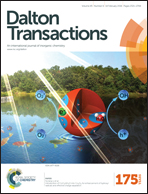Experimental and theoretical studies of structural phase transition in a novel polar perovskite-like [C2H5NH3][Na0.5Fe0.5(HCOO)3] formate†
Abstract
We report the synthesis, single crystal X-ray diffraction, and thermal, dielectric, Raman and infrared studies of a novel heterometallic formate [C2H5NH3][Na0.5Fe0.5(HCOO)3] (EtANaFe). The thermal studies show that EtANaFe undergoes a second-order phase transition at about 360 K. X-ray diffraction data revealed that the high-temperature structure is monoclinic, space group P21/n, with dynamically disordered ethylammonium (EtA+) cations. EtANaFe possesses a polar low-temperature structure with the space group Pn and, in principle, is ferroelectric below 360 K. Dielectric data show that the reciprocal of the real part of dielectric permittivity above and below the phase transition temperature follows the Curie–Weiss, as expected for a ferroelectric phase transition. Based on theoretical calculations, we estimated the polarization as (0.2, 0, 0.8) μC cm−2, i.e., lying within the ac plane. The obtained data also indicate that the driving force of the phase transition is ordering of EtA+ cations. However, this ordering is accompanied by significant distortion of the metal formate framework.
![Graphical abstract: Experimental and theoretical studies of structural phase transition in a novel polar perovskite-like [C2H5NH3][Na0.5Fe0.5(HCOO)3] formate](/en/Image/Get?imageInfo.ImageType=GA&imageInfo.ImageIdentifier.ManuscriptID=C5DT04536C&imageInfo.ImageIdentifier.Year=2016)

 Please wait while we load your content...
Please wait while we load your content...